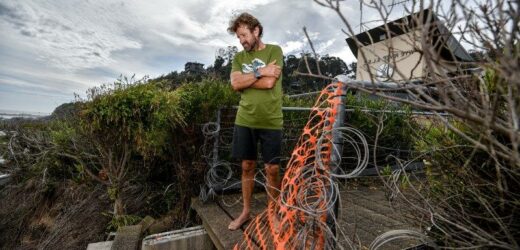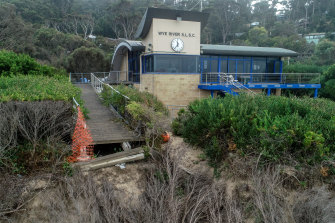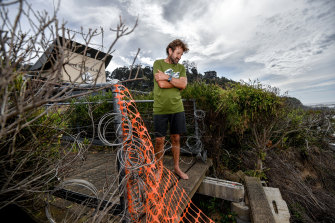In the popular holiday spot of Wye River, the community must soon decide how they will respond to the inevitable march of erosion at the beach: will it be fight or flight?
A change in the Wye River’s course has eaten away at a dune on the Great Ocean Road beach, resulting in the collapse of a disability access ramp attached to the surf life-saving club last year.
Damage to the ramp at Wye River. Credit:Joe Armao
A separate ramp that lifesavers used to get to the beach was also damaged.
Now authorities fear the club itself and a nearby camping ground will eventually come under threat.
Coast and riverine erosion, storms and large tides are attacking the Great Ocean Road’s cliff faces, beaches and built structures.
Some coastal experts believe authorities will eventually be forced to move sections of the Great Ocean Road itself to protect it from erosion.
In Wye River, the Great Ocean Road Coasts and Parks Authority is now consulting the community about long-term options to manage erosion of the dune system.
In a report, the authority offers a range of choices: retreating and moving the surf life-saving club further inland, building a solid sea wall, maintaining the sand — sometimes with heavy machinery or constructing physical barriers known as groynes to divert the water.
The authority’s coastal planning and projects officer, Oliver Nickson, said a sea wall could damage the beach while protecting the surf club.
“Sea walls tend to lower the beach in front of them which is due to wave reflection off the wall,” he said.
Mr Nickson said there were other instances along the Great Ocean Road where car parks were being retreated due to the advance of erosion.
Temporary measures to stop erosion at the Wye River surf life-saving club. Credit:Joe Armao
He said a retreat may be the only viable option in some locations along the coast where it would be too costly to build a sea wall.
The temporary sandbag groynes have helped to stabilise the dune at Wye River, but this is regarded as a short-term solution.
Consultation on the Wye River coastal adaptation plan closes later this month and the next steps will be announced in April.
Wye River surf life-saving club president Martin McIntosh said erosion had eaten away about 15 metres of sand and vegetation from the dune in front of the life-saving club.
Wye River resident and volunteer lifesaver Andrew Hack. Credit:Joe Armao
He said the Wye River community was resilient and had withstood other disasters, including the fires in 2015, but losing more of the beach would be a savage blow.
“Everyone was pretty concerned we’d lose the thing that keeps us all together in summer,” he said.
Wye River resident and surf life-saving club member Andrew Hack said it was deflating for the community to see the disability access ramp collapse and residents had raised concerns about it over the years.
He said the beach was constantly changing but for the past two summers the river had run at right angles to its previous course.
An aerial view of Wye River. Credit:Joe Armao
“When you live on the coast you see nature do its best and worst in terms of destroying things. You accept that,” he said.
But he agreed building walls would be an unpopular option.
“I think most people would be against building hard structures such as sea walls.”
Nearby in Apollo Bay, car parks have been damaged by erosion and an engineers report in 2019 recommended rerouting sections of the Great Ocean Road due to flooding and rising sea levels.
University of Melbourne and RMIT professorial fellow Chris Ryan, who is leading a project investigating options to protect the Great Ocean Road, said it was inevitable that parts of the tourist route would eventually have to be moved.
“I think it is, yes. The cost otherwise is too large,” he said.
Professor Ryan said it was impossible to build walls all along the coast to protect the road.
“We’re going to have the Great Ocean Wall and not the Great Ocean Road.”
Monash University architecture department senior lecturer, Catherine Murphy and students have been examining the advantages for residents and tourism of moving the road inland between Skenes Creek and Marengo.
“If you do move it you’ve got all this new open space,” she said. “You could ride on it. You could walk on it until in the long term it might not be there anymore.”
The state government has recently said it has no intention of moving parts of the Great Ocean Road.
The Morning Edition newsletter is our guide to the day’s most important and interesting stories, analysis and insights. Sign up here.
Most Viewed in National
From our partners
Source: Read Full Article






